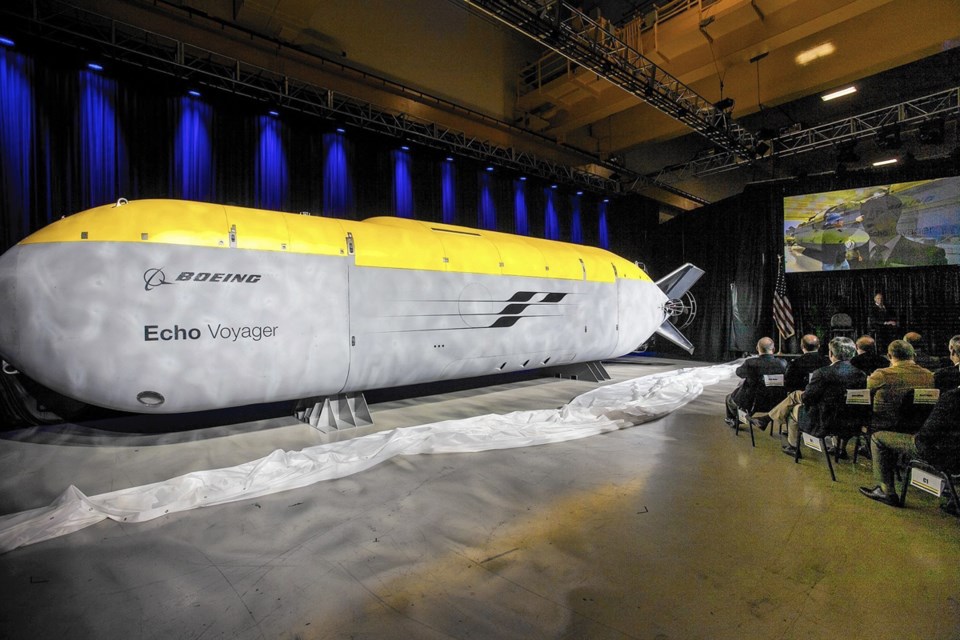You’ve heard about drones, those small helicopters that kids, big and small, fly around to take photos and video. And self-driving cars are just starting to make inroads into our everyday lives.
Now, a Richmond battery research and manufacturing firm is helping power a transit bus-sized, unmanned submarine that can, thanks to its hybrid, rechargeable power source, stay on its task for up to six months.
Built by Boeing, known mostly for commercial aircraft products, the 51-foot-long Echo Voyager uses a series of lithium ion batteries made by Corvus Energy Ltd. that are recharged by the sub’s diesel generator.
“They (Boeing) came to us about five years ago wanting a custom battery pack for their smaller, 18-foot long, Echo Ranger. And as they moved on to other platforms, we produced updated versions,” said Allan Grant, vice president of business development with Corvus Energy.
“The Echo Ranger was launched by a crane from the deck of a ship, while the Voyager is so large it’s towed out to sea by a ship and released, like Free Willy,” quipped Grant.
When the batteries in the unmanned undersea vehicle (UUV) — it’s official designation — need recharging, it can come close to the surface, extend its short mast, that allows it to link up with data communications and recalibrate its global positioning and navigation information, and also take in fresh air and expel exhaust to run the diesel generator.
“It can dive to a depth of 4.7 km,” Grant said. “Our batteries give it that extended range. It can also go from Los Angeles to Hong Kong.”
The benefits of having a submarine that can be programmed to remain on a job for extended periods is of particular interest to clients in the offshore oil and gas industry.
“A lot of the (ocean) oil rigs are in deep water, floating, and not actually tethered to the ocean bed. And a vehicle like the Voyager can go down and survey the pipelines under the rigs and see what kind of shape they are in.”
It’s independence also lessens the need, and cost, of a support ship to monitor and re-supply it.
The Echo Ranger which was powered entirely by Corvus-made batteries and could only stay at sea for a couple of days was used to survey ship wreckage from post Second World War atomic bomb testing. In contrast, the Echo Voyager can do deep water oceanographic research and also serve as a platform for military uses.
“Batteries just store energy, they don’t create it. So, you need to have a way of recharging it, especially for those longer missions,” Grant said. “They could put that type of sub into the Gulf Stream and it could sample water for months. So, they’ve opted to build a much bigger vehicle with a lot more stuff inside it, instrumentation and other kinds of electronics. And the only time you have to (completely) surface is when it runs out of fuel.
The battery pack onboard the Echo Voyager is about as long as a pick up truck and is roughly three feet high and can run without recharging for a few days.
Grant said he could not say exactly how much energy storage the batteries provide — that’s a closely guarded secret — but confirmed the batteries use lithium ion technology, albeit that which is dramatically different to the ones you find in laptop computers and cellphones.
“There are six major chemistries of lithium on the market,” he said.
Lithium ion phosphate is used in cordless tools and machines such as electric drills, lawn mowers and vacuums. The nickel manganese cobalt version powering the submarine is meant for larger, industrial-scaled applications that produce consistently large amounts of energy.
“It’s a very stable chemistry and doesn’t have the energy density required for something like a cellphone,” he said.
Recharging time is rapid, given the submarine is meant to spend limited time near the surface.
“You don’t want to loiter around for too long,” Grant said.
Cells for the batteries are made in South Korea by a firm called Kokam and the remainder of the work is done at Corvus Energy’s east Richmond facility just south of the IKEA store, with source materials supplied by companies across the Lower Mainland and around the globe.



